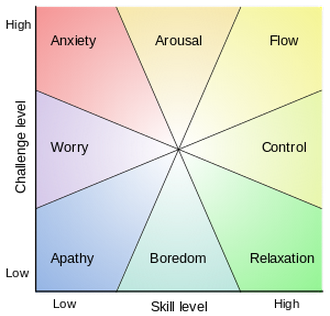Mihaly Csikszentmihalyi in his 1990 book Flow: The Psychology of Optimal Experience outlines his theory that people both feel their best and perform their best when they are in a state of flow— a state of concentration or complete absorption with the activity at hand.

Recently Steven Kotler in his 2015 book The Rise of Superman has taken up the ideas of Csikszentmihalyi. While Csikszentmihalyi held that there were 9 components to achieving flow, Steven Kotler has expanded this list to 17, broken down into psychological (4), environmental (3), social (9), and creative (1) triggers. So without further ado,
The 17 Triggers of Flow
PSYCHOLOGICAL (triggers that drive attention into the now)
1. Intensely Focused Attention
Producing flow requires long periods of uninterrupted concentration. Deep focus. This means multi-tasking is out. Open office plans as well. Flow demands singular tasks and it demands solitude.
2. Clear Goals
Know what you're doing and why you're doing it - that's the point. When goals are clear, the mind doesn't wonder what it has to do next, it already knows. Our focus can stay pinned to the present moment and the present action.
3. Immediate Feedback
As a focusing mechanism, immediate feedback is something of an extension of clear goals. Clear goals tell us what we're doing; immediate feedback tells us how to do it better.
4. The Challenge/Skills Ratio
Flow exists near (but not on) the mid-line between boredom and anxiety. If the task is too dull, attention disengages and action and awareness cannot merge. If the task is too hard, fear starts to spike, and we begin looking for ways to extricate ourselves from the situation.
ENVIRONMENTAL (qualities in the environment that drive you into the zone.)
5. High Consequences
When there's danger lurking in the environment, we don't need to concentrate extra hard to drive focus, because the elevated risk levels do the job for us.
6. Rich Environment
A rich environment means an environment with lots of novelty, unpredictability and complexity - three things that catch and focus our attention much like risk.
7. Deep Embodiment
Deep embodiment is paying attention to multiple sensory streams at once. When we capture multiple senses at once it drives attention into the now.
SOCIAL (triggers to alter social conditions to produce more group flow)
8. Serious Concentration
Groups need to be focused on the task at hand with maximum attention to the here and now, blocked off from other distractions.
9. Shared, Clear Goals
Groups need to be clear about what their collective goal is in order for flow to happen. The goal must provide enough focus so team members can tell when they are close to a solution, but open enough for creativity to exist.
10. Good Communication
Constant communication is necessary for group flow. Listen closely to what is being said, accept it, and build upon it. Nothing blocks flow more than ignoring or negating a group member.
11. Familiarity
The group has a common language, a shared knowledge base and a communication style based on unspoken understandings. It means everybody is always on the same page, and, when novel insights arise, momentum is not lost due to the need for lengthy explanation.
12. Equal Participation (and Skill Level)
Flow is most likely to happen in a group setting when all participants have an equal role in the project. For this reason, all members should have similar skill levels.
13. Risk
The potential for failure. Innovation and frequent failure go hand in hand. There is no creativity without failure, and there's no group flow without the risk of failure. Mental, physical, creative, whatever - the group has to have some skin in the game to produce flow.
14. Sense of Control
Combines autonomy (being free to do what you want) and competence (being good at what you do). It's about getting to choose your own challenges and having the necessary skills to surmount them.
15. Close Listening
We're fully engaged in the here and now. In conversation it isn't thinking about what witty thing to say next, or what cutting sarcasm came last. Rather, it's generating real time, unplanned responses to the dialogue as it unfolds. Innovation is blocked when one or more participants already has a preconceived idea of what the person is going to say, or how to get to a goal.
16. Always Say Yes
This means interactions should be additive more than argumentative. The goal is the momentum, togetherness, and innovation that comes form amplifying each other's ideas and actions.
17. CREATIVITY (as Pattern Recognition and Risk-Taking)
Pattern recognition is the brain's ability to synthesize and link new ideas together, while risk-raking is the courage to bring those new ideas into the world. Both of these aspects of creativity are important flow triggers.
